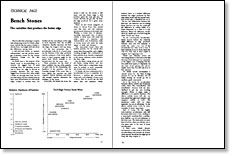
Synopsis: The woodworker planning to acquire new sharpening stones for chisels, plane irons and the like has quite a variety to choose from. This article explains the differences among them.
The woodworker planning to acquire new sharpening stones for chisels, plane irons, and the like has quite a variety to choose from, and might well ask about the differences among them.
A talk with Jack Heath, an amateur cabinetmaker, and also product manager of abrasive stones for the Norton Company, brings out the key differences.
As Heath sees it, the purpose of the bench stone in woodworking is to remove the ragged burr of metal resulting from the grinding process, and to leave the edge as smooth as possible. Butchers like the sharp, ragged burr because that’s what makes a knife cut through meat best, but for woodworkers, the burr merely picks up heat, tears off and leaves an even worse edge. Looked at another way, for hardwoods the smoothness of the edge is more important than the so-called sharpness. Equally important, the finer the edge, the longer it will stay sharp.
So the key properties that a woodworker looks for in a bench stone are the fineness of the edge produced and the resistance of the stone itself to wear. A third property might be the speed with which material is removed—how fast the stone cuts.
These properties are the result of three variables: the size of the particles (or grit) that do the sharpening, the hardness of the particles, and the bonding strength of the stone, that is, how tightly the particles are held together. Particle hardness and bonding strength together determine the hardness of the stone.
Generally, the harder the stone, the slower it will cut, the slower it will wear, and the better edge it will produce, given the same grit size. Of course, the finer the grit size, the finer the edge produced, for a given stone hardness.
There are two broad categories of stones to choose from: first, natural ones like hard and soft Arkansas (pronounced Arkansas in the trade) and .Washita, a coarser form of Arkansas; secondly, man-made ones of silicon carbide (a black stone sold under the trade names of Crystolon and Carborundum) and of aluminum oxide (a brown stone sold under the trade names of India and Aloxite).
The man-made stones have the hardest particles, but the natural silica stones have finer particles and a higher bonding strength. This combination of finer particles more densely compressed is the reason Arkansas stones produce the finer edge.
But the finest cutting stones are not the fastest cutting stones, and vice versa. That’s why a compromise stone must be picked, or more commonly, two stones used consecutively.
To Heath, the best combination for a woodworker—if cost is somewhat of a factor—is a medium grit man-made stone and a soft Arkansas. If cost is not a factor, then he would use the hard rather than soft Arkansas.
From Fine Woodworking #1
For the full article, download the PDF below:
Fine Woodworking Recommended Products

Starrett 12-in. combination square

Suizan Japanese Pull Saw

Wen Diamond Grinding Wheel






















Log in or create an account to post a comment.
Sign up Log in